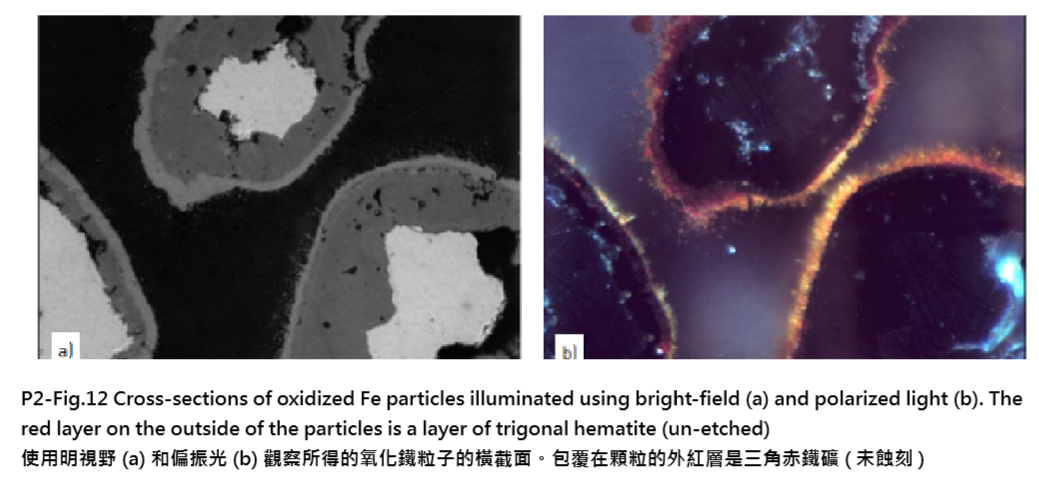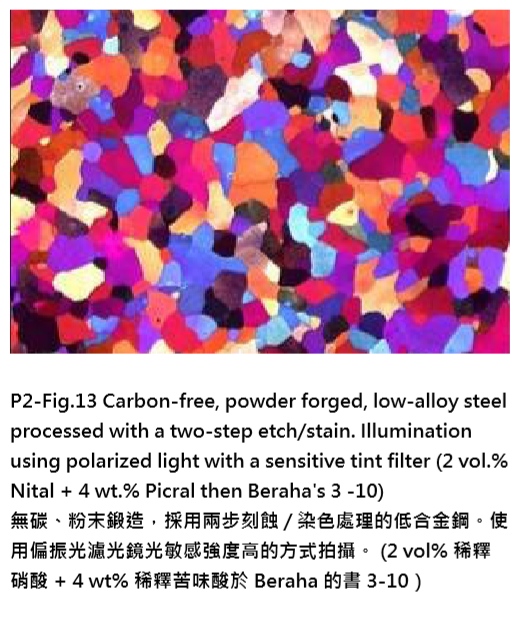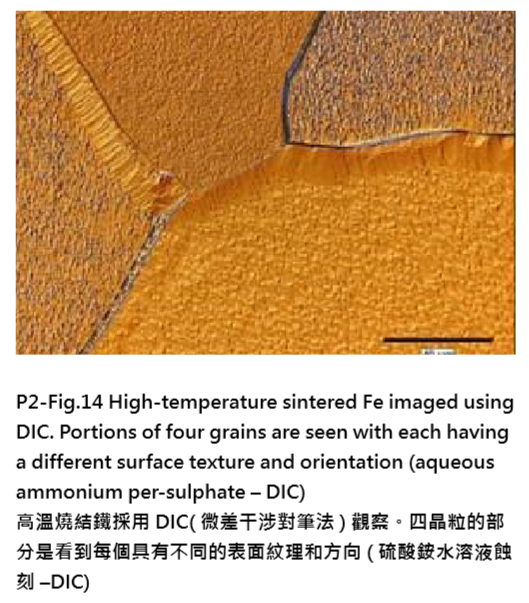Introduction to Metallographic for Powder Metallurgy 粉末冶金金相技術 II(六)
2.5.1 Polarised and bright-field illumination偏振像和明場像
P2-Fig.12 shows a layer of hematite (Fe2O3) on the outside surface of several iron particle crosssections. Although Fe is cubic in structure, hematite is hexagonal and responds to polarised light with a characteristic red colour. Image ‘a’ shows the metallic Fe and oxide layers using bright-field illumination. In contrast, P2-Fig.12b is the same field using polarised light for illumination and showing the red hematite layer. P2-圖.12所示為幾個鐵粉顆粒外表面上的鐵紅(Fe2O3) 的截面形貌。儘管Fe是立方晶格結構,但是其氧化物 鐵紅卻是六方晶格,在偏振光下會顯現紅色的特徵顏 色。圖a是白光下看到的金屬Fe與氧化層的形貌(明視 野),圖b是同一區域在偏振光下看到的圖像,從中可 以很清楚地分辨出紅色的氧化物層。

2.5.2 Anisotropic interference layer 各向異性干涉膜
Another technique that takes advantage of the benefits of polarised light consists of depositing a layer of anisotropic material on the surface of a sample. As presented in the previous section, the
etch/ stain procedures deposit interference layers on the surfaces in varying thicknesses, with the relative thickness determined by several factors. The example seen in P2-Fig.13 is a powder forged, carbon-free, low-alloy steel (cubic) specimen with an anisotropic interference layer deposited on the surface. The variation in colour is due to orientation differences with the individual ferrite grains, shown by changes in deposited layer thickness and the response to polarised light. 為了利用偏振光的特性,還可以在樣品表面沉積一層 各向異性的干涉膜。如前所述,經過蝕刻/著色處理 後,樣品表面不同的物相上會沉積出厚薄不同的干涉 膜。 P2-圖.13所示為一種無碳低合金粉末鍛造鋼(立 方晶格)樣品,經過著色處理在樣品表面沉積出各向 異性的干涉膜後在偏光顯微鏡下所看到的圖像。不同 取向的晶粒上沉積膜的厚度不同,在偏振光下就可以 看到各種不同的顏色。

2.5.3 Differential interference contrast 微差干涉對比
Polarized light is also used for other microscopy techniques such as differential interference contrast
(DIC), where the response of the material being examined does not depend on crystal structure. In this case, the polarized light is passed through a prism before and after striking the sample and results in the ability to view differences in levels, textures, and bevels on the etched or processed sample surface. The example shown in P2-Fig.14 is an etched, high-temperature sintered iron where the individual grains can be seen on different levels with the texture seen as shadowed details.
In some cases, the grain boundaries are displayed as tilted edges rather than well-defined ‘lines’ separating grains. 另外一些利用偏振光進行金相觀察的技術則與材料晶 格結構無關,如微差干涉對比法(DIC)。在這種方法 中,偏振光打到樣品表面之前及反射回來之後都要通 過一個棱鏡,這樣就可以將經過蝕刻或其它處理後樣 品表面各區域的微小高差、紋理、斜面等表現為圖像 上對比的差異。 P2-圖.14所示為一種高溫燒結純鐵 樣品蝕刻後的DIC圖像,從中可以看到幾個晶粒的腐蝕深度不同,可以清楚地觀察到晶粒上的紋理細節, 有些晶界並不是嚴格的線狀,而是擴展成一個斜面。

2.6 Safety安全問題
Many chemicals are used in the metallographic processes of preparation, cleaning, etching and staining. These individual chemicals, the combinations of chemicals and, frequently, the chemical vapours are hazardous and should be treated with both respect and proper care. The types of hazards they present are many. They may be flammable, explosive, toxic and/or corrosive, all of which pose a danger to the user. It should be remembered at all times that the use and disposal of the chemicals must be carefully and thoughtfully controlled. 金相樣品的準備、清潔、蝕刻、著色等過程中要用到 許多化學試劑,這些試劑或試劑混合物及其蒸氣通常 都有易燃、易爆、有毒、腐蝕性等特性,因此在操作 的時候要特別小心,避免發生意外。
2.6.1 Safety Data Sheets安全資料表
Safety information is available for virtually all the materials and chemicals we use. This information is in the form of Safety Data Sheets (SDS) or, formerly, Material Safety Data Sheets (MSDS). Many companies, including the manufacturers and suppliers of materials and chemicals, create and revise these documents as needed. They are readily available to any interested party without charge and should be read before using any chemical or combination of chemicals. In addition to the dangers of using the chemicals, the SDS also includes precautions for chemical storage, exposure limits, and gives procedures for first aid and emergency occurrences. Although many potentially dangerous materials are used in metallography, they can and are used without incident when safety precautions are followed.
我們用到的所有材料和化學品與安全相關的資訊都 可以從安全資料表(SDS)或早期的材料安全資料表 (MSDS)中查到。生產商或供應商負責制訂這些檔, 並根據需要進行修訂。任何團體都可以免費獲得這些 資訊,在使用這些材料和化學品之前應當仔細閱讀安 全資訊。只要遵從安全指導,在金相分析中使用相應 的化學物質就不會發生意外事故。
2.6.2 Color coded labeling 顏色編碼標籤
Several organizations are excellent sources of information on the hazards of materials and chemicals. In the United States, two of these are the National Fire Protection Agency (NFPA) and the Hazardous Materials Information System (HMIS). Both have created systems which show the relative hazards of specific chemicals using a colour-coded label and numbering system. The colour-coded areas on the label show information on health, fire (flammability) and reactivity hazards, in addition to a numbering system within each colour-coded area ranging from 0 to 4, where the higher the number, the greater the hazard. The HMIS label also shows the Personal Protection Equipment (PPE) that should be worn with each potentially dangerous chemical. These labels are usually included on the SDS for a particular chemical. 對材料和化學物質的危害,有幾個組織是很好的資 料來源。在美國,這些都是兩個美國國家防火協會 (NFPA)和有害物質資訊系統(HMIS)。都創建了很好 的系統,顯示特定化學品的相對危險,使用顏色編碼 的標籤和編號系統。顏色對健康的標籤資訊顯示區、 火(燃燒)和反應性的危害,除了一個編號系統內的 每一個顏色編碼區域範圍從0到4,其中的數量越高,危險性越大。 HMIS的標籤也顯示了個人防護設備 (PPE),應佩戴每個潛在的危險化學。這些標籤通常包 括在一個特定的化學物質的。
Recommended reading推薦閱讀
Several metallography-related references are included to provide both general and specific information on the practices of metallography. The individual volumes may not speak directly to Powder Metallurgy applications, but the basic information on sample preparation, etching, revealing and interpreting the microstructures can be useful in analysing PM microstructures. 幾本金相相關參考文獻提供的一般和具體的對金相做 法的資訊。個別卷可能不會適合直接使用粉末冶金應 用,但樣品製備、蝕刻,揭示和解釋的微觀結構的基 本資訊可以是有用的,當你在分析粉末冶金結構時。
●Paul Beiss, Kirit Dalal, & Renate Peters, International Atlas of Powder Metallurgical Microstructures , First Edition, 2002, Metal Powder Industries Federation, Princeton, NJ, USA.
●Emanuel Beraha & Bilu Shpigler, Color Metallography , First Edition, 1977, American Society for Metals, Metals Park, OH, USA.
●Bruce Bramfitt & Arlan Benscoter, Metallographer’s Guide Practices and Procedures for Irons and Steels , First Edition, 2002, ASM International, Materials Park, OH, USA.
● George Kehl, Principles of Metallographic Laboratory Practice , Third Edition, 1949, McGrawHill Book Company, New York, NY, USA.
Acknowledgements謝志
The author would like to thank Dr. W Brian James for his suggestions, editing, and our many technical discussions. 作者表達對Dr. W Brain James、編者以及許多技術討 論者所給的建議。
References參考文獻
[1] T F Murphy, Introduction to Metallography for Powder Metallurgy: Part 1, Sample preparation techniques, Powder Metallurgy Review , Vol. 3, No. 4, 2014, pp. 29-37.■
